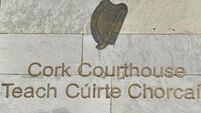Vintage view: Meissen 18th century group with bronze mounts

There are a few classical families of materials and things you should ground yourself in before exploring the cornucopia of objects that come up for sale on the antique scene.
Wandering around auctions, vintage markets and fairs, you can build on your experience, learning what’s good and what’s not, have the chance to handle these beautiful pieces and learn more from equally enchanted dealers — here and on holiday overseas.
Visiting somewhere special — the National Museum in Collins Barracks, the Victoria & Albert Museum in London or the Louvre in Paris, and simply looking at and appreciating the treasures available, even behind glass, becomes an enriching day out.
The symbol of the crossed swords of Meissen is something most of us would recognise as part of an elite name for antique objects. Produced from the early 1700s right through to today, German Meissen figures have a worldwide following for crisp modelling and decorative flair. Expensive and complex to produce they were luxurious, desirable, everything the gentry wanted on show in the 1730s for their town houses and country seats.
Let’s get the porcelain right first. Porcelain is grouped into soft-paste and hard-paste porcelain. Meissen is hard paste or ‘true’ porcelain — a mixture of china clay (kaolin) combined with ground china stone (a mineral known as petuntse) and ground quartz.
When fired it has strength, beauty and the ability to hold a lot of detail, making it ideal for exquisite intricate features, be it a flower petal or the turn up of a tiny Rococo maiden’s nose. When chipped or broken, the surface of hard paste porcelain will be shiny with acutely sharp edges. Turn over a figurine and check at the base for areas of slight damage and see if you can determine if it is clean white, with that glassy feel to any nicks.
Hard paste porcelain went into production around 1715 and the height of Meissen’s fame hits the middle of the 18th century when it’s chief modeller, (the term for the person designing and supervising the works), was Joachim Kaendler, active from 1733-1775, and closely followed by Peter Reinicke and J. F. Eberlein.
Kaendler is counted by some experts as one of the greatest artist of the 18th century. The flamboyant and greedy Elector of Saxony and King of Poland, Augustus the Strong, was wild about the early Oriental inspired work at Meissen and an enthusiastic patron.
He eagerly commissioned Kaendler for additions to his fabulous collection of Far Eastern porcelain accumulated for his dedicated ‘Japanese Palace’ near Dresden. Kaendler grew bored of Augustus’ Japanese and Chinese fantasies, and under the reign of Augustus III turned the factory towards more radical, eccentric themes for spectacular relief modelled dining services and figures.
His greatest breakthrough was the introduction of familiar characters as decorative single figures. Kaendler poked fun at Augustus’ courtiers’ elaborate dress, introduced nostalgia and romance with peasant men and women tending animals and playing instruments.
His series taken from the Italian Commedia dell Arte’ still thrill with their vivacity and excitement. The cast of Meissen characters drawn from folk tales, mythology, theatre and nature appeared ready to bound off the simple mound base in their vibrantly coloured costumes and romp, dance and spring across the mantle. Their pose and lightly frozen drama, were fascinating at a time when three dimensional entertainments were few and far between in upper class drawing-rooms and salons.
Many popular figures, such as pairs of lovers, were re-issued in the 19th century from original moulds but for many collectors the quality of painting and the fussier finishing to the base, knocked the appeal down a notch .
The base of a Meissen figure from the 19th century will be concave, larger and may carry gilding. By the later 1800s figures tend to be completely painted rather than leaving the stunning white porcelain on show. The faces of characters are often more sweet and sentimental, the implied movement of limbs and clothes less graceful, and the colours more garish too. If you see a chrome green or maroon colour, you can be sure the piece is Victorian as these colours were impossible in the 18th century.
Meissen is often confused with Dresden porcelain, a group of ceramics produced from the 1870s in an area about 15 miles away. The later Meissen marks come with crossed swords in under-glazed blue (without a dot between the scabbards), a heavily incised number to identity the model and the painter’s number.
Dresden porcelain will carry a blue crown. On early pieces, the Meissen sword can be quite blurry as it was often burned during firing. Look for it on the edge of the base, and get expert eyes and advice for a serious purchase.












